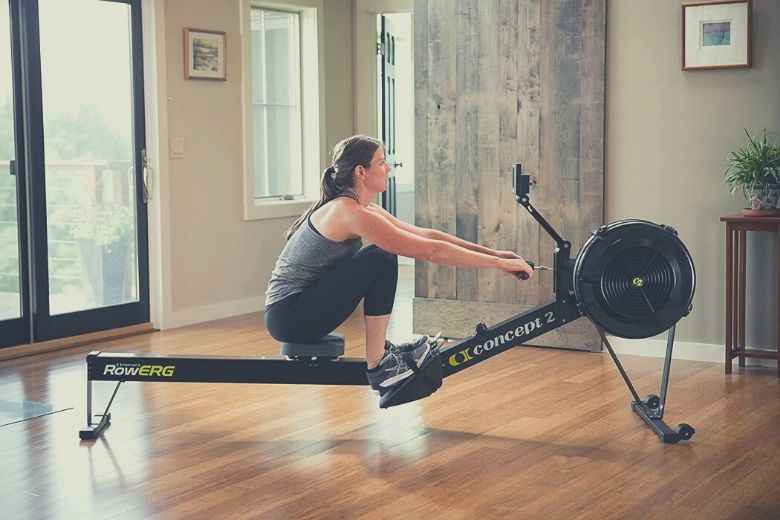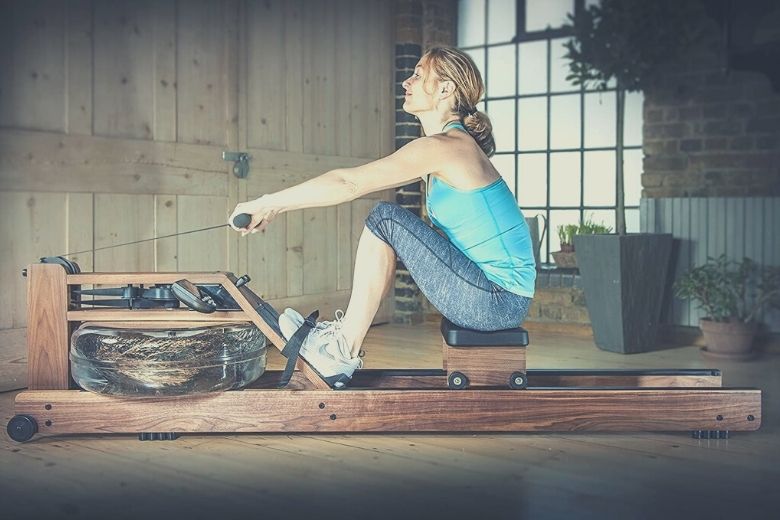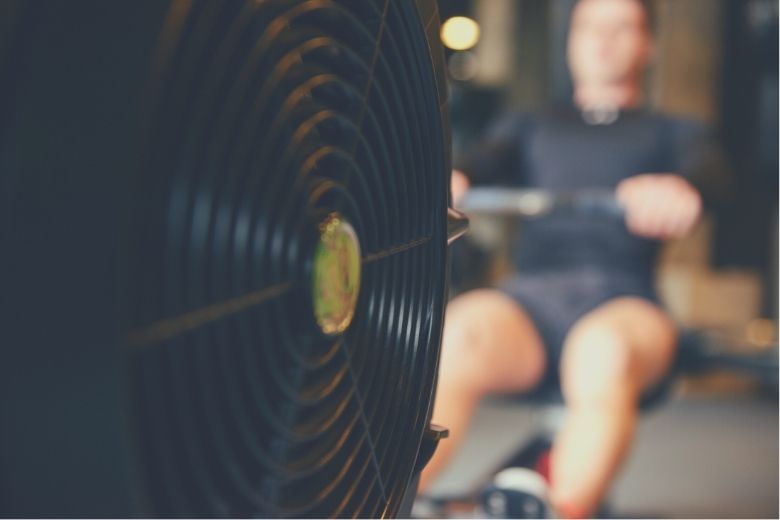It may sound like rocket science, but the most popular rowing machines create resistance using air, water, or magnets. Lower-end models play around with hydraulics. And while the fitness market is highly competitive, certain features make each rowing machine type and model stand out.
We’ll take a comprehensive look into the differences, technical specs, unique features, value for money, best use cases, and the pros and cons of each rowing machine.
If you’re a tech-savvy fitness buff, you’ll probably appreciate why most Olympic athletes, indoor rowing champions, and guys attempting world records settle for air rowing machines, for instance.
Let’s take a sneak-peek into each before we get to the air vs water vs magnetic rower showdown.
Contents
Air Rowing Machine
It isn’t a surprise that the air-driven or fan-based rowing machine graces most commercial gyms and homes. It offers a robust yet simple rowing stroke that is excellent for all types of workouts. To keep it simple this type of rowing machine creates resistance through air generated by the user’s efforts streamed through a flywheel.



The Concept2 Model D Indoor Rowing Machine – considered for many years by many to be the best rowing machine for elite and home use.
Check out our review
Here’s the fun part if you cherish the feel of your workouts: the harder you pull, the faster the fans will spin, and the more resistance you’ll feel. What’s even lovelier is that the resistance is controlled by speed so that there’s no real resistance limit.
Most air rowers boast damper settings. As such, you can control the amount of air into the flywheel housing and effectively, the resistance. It’s similar to how gears make you feel while pedaling a bike.
What’s more, the monitors on most high-quality air rowers are unmatched. They offer the best data accuracy regarding the force curves, heart rates, pace, 500 m split times, and power.
It’s then easy to assess the scores of various rowers on different rowing machines. Such beautiful accuracy can’t be achieved without accounting for the drag factor with each stroke.
You probably see why air-driven rowing machines are an Olympics athlete’s preference. The amount of info they provide is indispensable, especially if you’re a serious rower looking to compete or adhere to a strict training plan.
Pros
Air-driven rowers top the markets because of:
- High data accuracy
- Customizable, wide resistance ranges
- Smooth, balanced rowing experience
- Mimicking real rowing experience
Cons
- The whooshing sound can become a nuisance
- They tend to have less refined design features
Magnetic Rowing Machine
If you’ve ever felt the repulsion by moving identical poles of two magnets close together, you’ll quickly get a gist of the idea here.
Magnetic rowers offer resistance when a magnet moves either closer or further from the flywheel. There’s no significant physical contact between the magnet and the flywheel, and as such, these machines are virtually silent.
Think of this as an edge when you enjoy listening to music during workouts, watching TV and not disturbing your apartment neighbors.
Plus, the movements are smooth and consistent, as you’ll experience on your joints. By adjusting a dial or lever manually, you can seamlessly control the resistance. And once you’ve set the resistance to a level, say 5, it stays at that however fast or slows you row.
Resistance control comes in handy because if your focus is building muscle, you can easily increase resistance. Likewise, if your primary goal is cardiovascular fitness, you lower the resistance. Most magnetic rowers can be folded and have detachable sides, which is great news if you’re limited by space.
Magnetic rowers may feature simple or complex monitors, some of which have preset workout programs and games besides recording user data. While the data is accurate for personal use, it isn’t any inch close to that obtainable from an air-based rower.
Pros
On the upside, magnetic rowers have:
- Consistent, smooth motion
- Flexibility to various fitness goals
- Quiet
- Smaller size and compactness
- Wider range of preset programs
Cons
Most users won’t rate all five stars because of:
- Need for a power outlet in most models
- Manual resistance settings kill the natural feel.
Water Rowing Machine
The water rowing machine is the deal if you won’t mind a modern rower with a minimalist aesthetic and outstanding art-style design.



Water rowing machines bring the natural experience of the traditional lovely water sport to your home. They function through a transparent drum filled with water that sits just above the footrests. In this drum are paddles or fan blades.
As you row, the paddles hit the water, creating resistance. As such, you could adjust the resistance in one of two ways. You can opt to row faster to increase resistance or increase the water volume in the drum.
Conversely, by rowing slower or removing water from the reservoir drum, you decrease resistance.
While a water rower can be considerably noisy, it’s lovely if you consider the natural experience as though you were in an actual kayak or rowing boat.
You can hear the water braking, and you can experience the incredibly smooth motion.
You can enjoy your workouts with no side thoughts of pressure and strain in your joints. It’s also fascinating that the combination of speed and volume implies the resistance levels are infinite with a water rowing machine.
Pros
Water rowing machines are preferred as they:
- Offer unmatched aesthetics
- Relatively easy to maintain
- Mimic real-life rowing with Zen-like sounds
- Have unlimited resistance levels
- Have smooth stroke action, making them comfortable
Cons
Here’s the flip side:
- Their monitors aren’t as advanced.
- While they’re worth it, they retail at higher prices.
Air vs Water vs Magnetic Rower – The Features 101
You don’t just hop onto a rowing machine and start your workouts. While they have the same functionalities, subtle outcomes from differences that are quite considerable can influence your choice. Let’s break down these features.
Feel
All rowing machines require the same muscles and prompt the same movements. But if you want a clone of the natural experience of rowing on water, you have two options – an air or water rower.
Monitors and Data Accuracy
If you’re training for an event or some upcoming competition, you might want to look at accurate measurements. It’s the best way to infer your progress. Pros recognize the reputation of air-driven rowers because their monitors offer unmatched functionalities and data accuracies recommended for track records.
Resistance Control
Air rowers offer a smooth and strong resistance which only depends on the speed with which you’re rowing. Water rowers also come at par, with an even beautiful feel of rowing in real water.
The most remarkable feat about these two is that there are infinite resistance levels. Magnetic rowers, however, often feature a dial or a button on the monitor for predetermined resistance settings.
Noise Level
We can’t imagine another rowing machine that is as nearly silent as the magnetic rowers. Water and air rowers may not be a sweet deal if you prefer watching TV or listening to music during workouts.
Value for Money
Whichever rower type you’ve settled your heart on, lower-end models cost less—more advanced models with better features and quality retail for $1000 or more. Nevertheless, water rowing machines are by far the most exclusively priced.
So, what are the Outstanding Features for Each?
There’s more to each rowing machine, so let’s dive in briefly.
#1: Air Rowers
- Are lightweight as resistance is due to the action of a plastic fan.
- Great for High-Intensity Interval Training (HIIT)
#2: Magnetic Rowers
- Offer an almost serene environment during workouts – this is ideal if you’re in a small apartment and wouldn’t like neighbors to notice any noise.
#3: Water Rowers
- Take the quality stamp for aesthetics and could adorn your home gym.
Who Wins the Air vs Water vs Magnetic Rower Face-off?
It would sound too good to be true to find a rowing machine that’s a perfect fit for all. Depending on your fitness preferences and budget, you can land what suits you. While an air rowing machine is all rounded in terms of features and availability, it could sound like you’ve ignited a jet engine in your living room.
A water rower is beautiful and gives a natural feel, and is viable if you can overlook the price. A magnetic rower may be silent, but you can’t control the resistance infinitely.
Use an Air Rower if:
- You’re a serious athlete who can’t do without accurate data analytics as you pursue your goals.
Use a Magnetic Rower if:
- You’re noise conscious and highly care about keeping things calm and cool with neighbors in a teeny apartment.
Go for a Water Rower if:
- You want to mimic real-life rowing in water with uncapped resistance levels.
For an immersive and interactive rowing experience with all the bells and whistles take a look at our Aviron Rower Review.
The Wrap
We hope you enjoyed our air vs water vs magnetic rower guide! Make sure to leave us a comment. For more on rowers specifically, ones suitable for restricted space visit our article on the best rowers for apartments.

